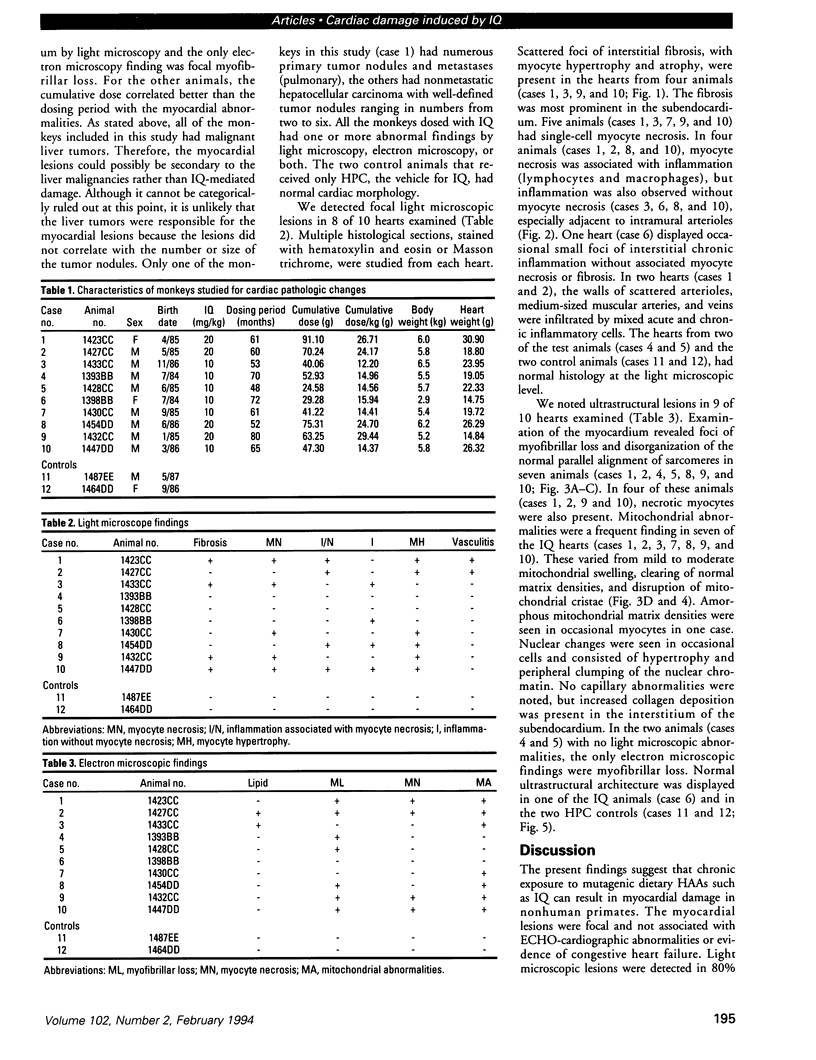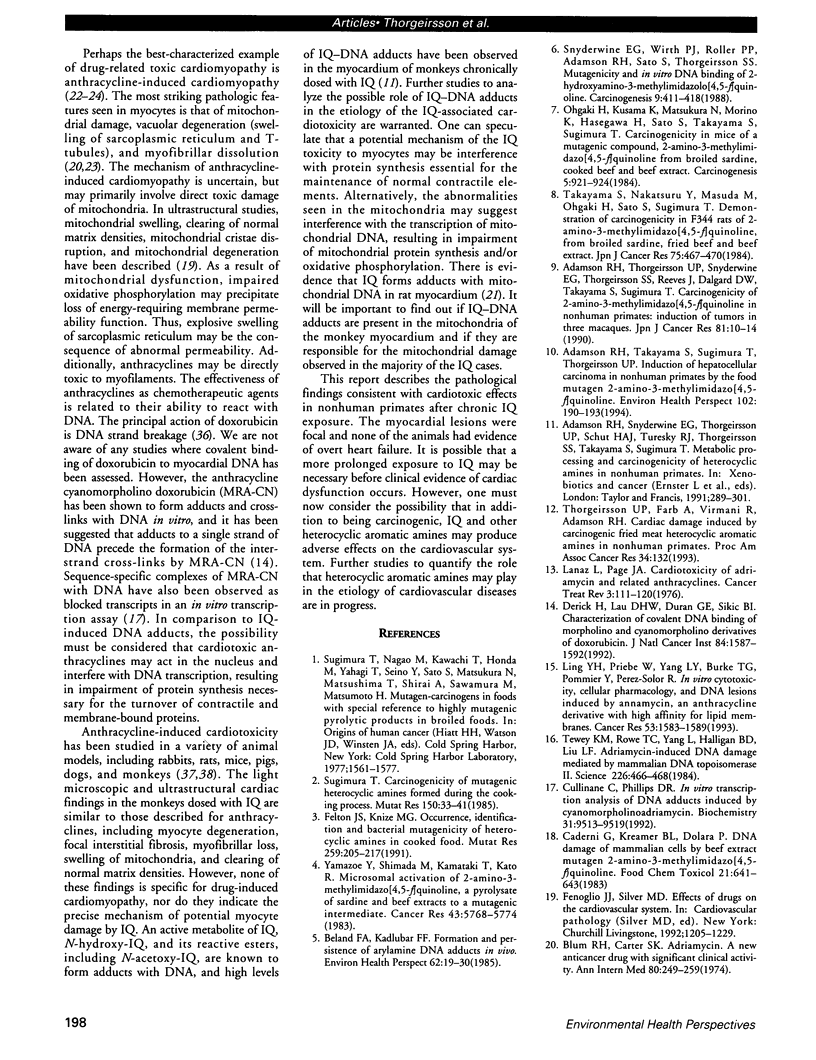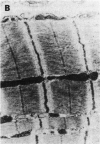Abstract
The heterocyclic aromatic amine 2-amino-3-methylimidazo[4,5-f]quinoline (IQ) is a potent hepatocarcinogen in cynomolgus and rhesus monkeys. The finding of high cardiac IQ-DNA adduct levels prompted a histopathological study of perfusion-fixed hearts from 10 tumor-bearing monkeys chronically dosed with IQ at 10 mg/kg or 20 mg/kg 5 days per week for 48-80 months. Two monkeys dosed only with the vehicle for IQ, hydroxypropylcellulose, served as controls. All the monkeys had normal heart weights, and no abnormalities were observed upon gross inspection of the hearts. Microscopically, focal myocardial lesions were observed in 8 of 10 monkeys dosed with IQ. Light microscopic abnormalities included myocyte necrosis with or without chronic inflammatory infiltrates, interstitial fibrosis with myocyte hypertrophy or atrophy, and vasculitis. Electron microscopic findings included disruption of the mitochondrial architecture (i.e., mitochondrial swelling and clearing of matrix densities), myofibrillar loss, disorganization of the normal alignment of sarcomeres, and occasional myocytes showing nuclear hypertrophy or peripheral clumping of the nuclear chromatin. There was some correlation between the cumulative dose of IQ and the extent of the myocardial abnormalities. These findings suggest that chronic exposure to IQ can lead to myocardial damage in monkeys. Although focal and not associated with clinical evidence of heart failure, these abnormalities may represent the initial stages of IQ-induced toxic cardiomyopathy.
Full text
PDF





Images in this article
Selected References
These references are in PubMed. This may not be the complete list of references from this article.
- Adamson R. H., Takayama S., Sugimura T., Thorgeirsson U. P. Induction of hepatocellular carcinoma in nonhuman primates by the food mutagen 2-amino-3-methylimidazo[4,5-f]quinoline. Environ Health Perspect. 1994 Feb;102(2):190–193. doi: 10.1289/ehp.94102190. [DOI] [PMC free article] [PubMed] [Google Scholar]
- Adamson R. H., Thorgeirsson U. P., Snyderwine E. G., Thorgeirsson S. S., Reeves J., Dalgard D. W., Takayama S., Sugimura T. Carcinogenicity of 2-amino-3-methylimidazo[4,5-f]quinoline in nonhuman primates: induction of tumors in three macaques. Jpn J Cancer Res. 1990 Jan;81(1):10–14. doi: 10.1111/j.1349-7006.1990.tb02500.x. [DOI] [PMC free article] [PubMed] [Google Scholar]
- Appelbaum F., Strauchen J. A., Graw R. G., Jr, Savage D. D., Kent K. M., Ferrans V. J., Herzig G. P. Acute lethal carditis caused by high-dose combination chemotherapy. A unique clinical and pathological entity. Lancet. 1976 Jan 10;1(7950):58–62. doi: 10.1016/s0140-6736(76)90151-3. [DOI] [PubMed] [Google Scholar]
- Beland F. A., Kadlubar F. F. Formation and persistence of arylamine DNA adducts in vivo. Environ Health Perspect. 1985 Oct;62:19–30. doi: 10.1289/ehp.856219. [DOI] [PMC free article] [PubMed] [Google Scholar]
- Blum R. H., Carter S. K. Adriamycin. A new anticancer drug with significant clinical activity. Ann Intern Med. 1974 Feb;80(2):249–259. doi: 10.7326/0003-4819-80-2-249. [DOI] [PubMed] [Google Scholar]
- Bristow M. R., Mason J. W., Billingham M. E., Daniels J. R. Doxorubicin cardiomyopathy: evaluation by phonocardiography, endomyocardial biopsy, and cardiac catheterization. Ann Intern Med. 1978 Feb;88(2):168–175. doi: 10.7326/0003-4819-88-2-168. [DOI] [PubMed] [Google Scholar]
- Bristow M. R., Thompson P. D., Martin R. P., Mason J. W., Billingham M. E., Harrison D. C. Early anthracycline cardiotoxicity. Am J Med. 1978 Nov;65(5):823–832. doi: 10.1016/0002-9343(78)90802-1. [DOI] [PubMed] [Google Scholar]
- Caderni G., Kreamer B. L., Dolara P. DNA damage of mammalian cells by the beef extract mutagen 2-amino-3-methylimidazo[4,5-f]quinoline. Food Chem Toxicol. 1983 Oct;21(5):641–643. doi: 10.1016/0278-6915(83)90153-9. [DOI] [PubMed] [Google Scholar]
- Cullinane C., Phillips D. R. In vitro transcription analysis of DNA adducts induced by cyanomorpholinoadriamycin. Biochemistry. 1992 Oct 13;31(40):9513–9519. doi: 10.1021/bi00155a001. [DOI] [PubMed] [Google Scholar]
- Felton J. S., Knize M. G. Occurrence, identification, and bacterial mutagenicity of heterocyclic amines in cooked food. Mutat Res. 1991 Mar-Apr;259(3-4):205–217. doi: 10.1016/0165-1218(91)90118-6. [DOI] [PubMed] [Google Scholar]
- Gottdiener J. S., Appelbaum F. R., Ferrans V. J., Deisseroth A., Ziegler J. Cardiotoxicity associated with high-dose cyclophosphamide therapy. Arch Intern Med. 1981 May;141(6):758–763. [PubMed] [Google Scholar]
- HIBBS R. G., FERRANS V. J., BLACK W. C., WEILBAECHER D. G., BURCH G. E. ALCOHOLIC CARDIOMYOPATHY; AN ELECTRON MICROSCOPIC STUDY. Am Heart J. 1965 Jun;69:766–779. doi: 10.1016/0002-8703(65)90450-3. [DOI] [PubMed] [Google Scholar]
- Herskowitz A., Willoughby S. B., Baughman K. L., Schulman S. P., Bartlett J. D. Cardiomyopathy associated with antiretroviral therapy in patients with HIV infection: a report of six cases. Ann Intern Med. 1992 Feb 15;116(4):311–313. doi: 10.7326/0003-4819-116-4-311. [DOI] [PubMed] [Google Scholar]
- Karch S. B., Billingham M. E. The pathology and etiology of cocaine-induced heart disease. Arch Pathol Lab Med. 1988 Mar;112(3):225–230. [PubMed] [Google Scholar]
- Kesteloot H., Roelandt J., Willems J., Claes J. H., Joossens J. V. An enquiry into the role of cobalt in the heart disease of chronic beer drinkers. Circulation. 1968 May;37(5):854–864. doi: 10.1161/01.cir.37.5.854. [DOI] [PubMed] [Google Scholar]
- Lau D. H., Durán G. E., Sikic B. I. Characterization of covalent DNA binding of morpholino and cyanomorpholino derivatives of doxorubicin. J Natl Cancer Inst. 1992 Oct 21;84(20):1587–1592. doi: 10.1093/jnci/84.20.1587. [DOI] [PubMed] [Google Scholar]
- Lenaz L., Page J. A. Cardiotoxicity of adriamycin and related anthracyclines. Cancer Treat Rev. 1976 Sep;3(3):111–120. doi: 10.1016/s0305-7372(76)80018-7. [DOI] [PubMed] [Google Scholar]
- Levin M., Silber R., Israel M., Goldfeder A., Khetarpal V. K., Potmesil M. Protein-associated DNA breaks and DNA-protein cross-links caused by DNA nonbinding derivatives of adriamycin in L1210 cells. Cancer Res. 1981 Mar;41(3):1006–1010. [PubMed] [Google Scholar]
- Lewis W., Papoian T., Gonzalez B., Louie H., Kelly D. P., Payne R. M., Grody W. W. Mitochondrial ultrastructural and molecular changes induced by zidovudine in rat hearts. Lab Invest. 1991 Aug;65(2):228–236. [PubMed] [Google Scholar]
- Ling Y. H., Priebe W., Yang L. Y., Burke T. G., Pommier Y., Perez-Soler R. In vitro cytotoxicity, cellular pharmacology, and DNA lesions induced by annamycin, an anthracycline derivative with high affinity for lipid membranes. Cancer Res. 1993 Apr 1;53(7):1583–1589. [PubMed] [Google Scholar]
- McAllister H. A., Jr, Ferrans V. J., Hall R. J., Strickman N. E., Bossart M. I. Chloroquine-induced cardiomyopathy. Arch Pathol Lab Med. 1987 Oct;111(10):953–956. [PubMed] [Google Scholar]
- Ohgaki H., Kusama K., Matsukura N., Morino K., Hasegawa H., Sato S., Takayama S., Sugimura T. Carcinogenicity in mice of a mutagenic compound, 2-amino-3-methylimidazo[4,5-f]quinoline, from broiled sardine, cooked beef and beef extract. Carcinogenesis. 1984 Jul;5(7):921–924. doi: 10.1093/carcin/5.7.921. [DOI] [PubMed] [Google Scholar]
- Peng S. K., French W. J., Pelikan P. C. Direct cocaine cardiotoxicity demonstrated by endomyocardial biopsy. Arch Pathol Lab Med. 1989 Aug;113(8):842–845. [PubMed] [Google Scholar]
- Ratliff N. B., Estes M. L., Myles J. L., Shirey E. K., McMahon J. T. Diagnosis of chloroquine cardiomyopathy by endomyocardial biopsy. N Engl J Med. 1987 Jan 22;316(4):191–193. doi: 10.1056/NEJM198701223160405. [DOI] [PubMed] [Google Scholar]
- Sieber S. M., Correa P., Young D. M., Dalgard D. W., Adamson R. H. Cardiotoxic and possible leukemogenic effects of adriamycin in nonhuman primates. Pharmacology. 1980;20(1):9–14. doi: 10.1159/000137337. [DOI] [PubMed] [Google Scholar]
- Smith H. J., Roche A. H., Jausch M. F., Herdson P. B. Cardiomyopathy associated with amphetamine administration. Am Heart J. 1976 Jun;91(6):792–797. doi: 10.1016/s0002-8703(76)80545-5. [DOI] [PubMed] [Google Scholar]
- Snyderwine E. G., Wirth P. J., Roller P. P., Adamson R. H., Sato S., Thorgeirsson S. S. Mutagenicity and in vitro covalent DNA binding of 2-hydroxyamino-3-methylimidazolo[4,5-f]quinoline. Carcinogenesis. 1988 Mar;9(3):411–418. doi: 10.1093/carcin/9.3.411. [DOI] [PubMed] [Google Scholar]
- Sugimura T. Carcinogenicity of mutagenic heterocyclic amines formed during the cooking process. Mutat Res. 1985 Jun-Jul;150(1-2):33–41. doi: 10.1016/0027-5107(85)90098-3. [DOI] [PubMed] [Google Scholar]
- Takayama S., Nakatsuru Y., Masuda M., Ohgaki H., Sato S., Sugimura T. Demonstration of carcinogenicity in F344 rats of 2-amino-3-methyl-imidazo[4,5-f]quinoline from broiled sardine, fried beef and beef extract. Gan. 1984 Jun;75(6):467–470. [PubMed] [Google Scholar]
- Tewey K. M., Rowe T. C., Yang L., Halligan B. D., Liu L. F. Adriamycin-induced DNA damage mediated by mammalian DNA topoisomerase II. Science. 1984 Oct 26;226(4673):466–468. doi: 10.1126/science.6093249. [DOI] [PubMed] [Google Scholar]
- Yamazoe Y., Shimada M., Kamataki T., Kato R. Microsomal activation of 2-amino-3-methylimidazo[4,5-f]quinoline, a pyrolysate of sardine and beef extracts, to a mutagenic intermediate. Cancer Res. 1983 Dec;43(12 Pt 1):5768–5774. [PubMed] [Google Scholar]
















